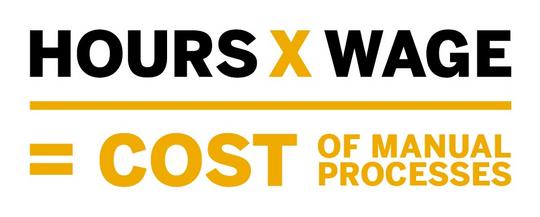What's Your Spend Management Costing You?
You’ve hit your spending limit. Using manual, paper-based, and outdated systems to track expenses is costing your organization money and your own employees sanity. With employees spending more money across more channels than ever before, the difficulty of keeping track of spend as an organization is sky rocketing. Answer this question to see where your own organization currently stands:
Of the list below, what do you want to be true for your company?
- Streamlined Systems
- Maximized productivity
- Accurate spend data
- Enabled and Satisfied Employees
- Efficient Spending
- All of the Above
Doing things the hard way is also an expensive way. It costs 39% of businesses more than $6 to process a single invoice. Multiply that by the number of expense reports you handle each month and you could be looking at a pretty substantial hit. And that’s just the tip of the iceberg:
- It takes 26 minutes on average to complete one expense report.
- The average cost to process one expense report can be as high as $25 per invoice.
- On average, 19% of expense reports have errors which take valuable time to fix.
- Using a manual process can be costing you as much as $34,039 per 10,000 invoices.
What does the average expense report cost for your organization? Let’s do the math. The number of hours spent on expense reports multiplied by the average hourly salary of your staff, divided by the number of expense reports you process per year, will give you your organization’s customized number. It looks like this: (Hours spent annually on expense reports) x (Average hourly rate of your processing staff) ÷ (Number of expense reports per year) = Cost per expense report
Now that you know how much your expense report is costing you, let’s dive into automation can help.
Stay streamlined
You can happily say goodbye to inefficient, manual processing and say hello to an automated and connected travel, expense, and invoice solution. With automation on your side, your organization can confidently operate with reliable and streamlined expense data. Removing unnecessary steps, such as printing out documents and manually filling out information, will not only benefit today’s processes but multiply in value as your organization grows and changes. Still not convinced? Then ask yourself these four questions:
- Is your accounts payable invoice system scalable for growth?
- Could your expense process be simplified with a streamlined solution?
- Are your employees and stakeholders getting frustrated with your process?
- Do you have the necessary technology support needed to keep your invoice system running seamlessly?
Maximize productivity
As employee spending becomes more complex, the manual reporting process gets even more painful, making your reports a recipe for wasted hours, days, and dollars. This translates into finance and AP personnel spending a significant amount of their time with manual tasks, while financial decision makers spend a lot more of their time trying to analyze and interpret data. Hours spent x Employee hourly wage = Cost of manual process

With the help of automated, integrated solutions, you can move many manual, frustrating, and mundane tasks off your employees' plates and free up more time for yourself and others to focus on strategic tasks that promote growth. Attaining efficiencies in AP workflows alone results in spending 68% less time processing invoices – just imagine what you could do with all that free time.
Report accurately
Everybody makes mistakes but when 10% of invoices have errors, something needs to change. Companies who use a mixture of paper and spreadsheets to process expenses are especially prone to this problem. Paper receipts can get lost, and it’s not hard to imagine the manual errors that can crop up when copying data into a form. Manual processes are prone to inaccurate data entry and even fraudulent practices, which can result in the following:
- 20% of businesses say that reconciling duplicate invoices is among their top challenges with processing paper invoices, according to IOFM’s research.
- Inventories can easily be off with data entry, causing overcharges—all of which can cause mistrust and confusion between you, your customers and your employees.
Updating to automation can reduce these errors by more than 90%. By catching duplicate entries, and automatically flagging expenses outside of policy, the back and forth from your employee to your accounting team is virtually eliminated. All communication can be handled within the system, and completely documented for auditing purposes.
Improve employee satisfaction
Reducing your employees time spent manually creating and entering expenses, plus eliminating the need to keep up with paper receipts, lightens the load and boosts morale within your organization. Automating your workflows and implementing best practices for your accounting staff will significantly improve accuracy, cycle time, and employee satisfaction.
But the frustration doesn’t end with submitting expenses. Employees often wait a long time to get reimbursed too. The average time is 8 days from approval to reimbursement, but sometimes it can take even longer. And that’s a whole lot of time spent shouldering an out-of-pocket expense. Thanks to automation, ease of use, and the availability of apps on mobile devices, various groups of employees are saving substantial time to submit and review expenses.
Easy-to-use mobile tools that provide consumer-like experiences at work connect your employees to the apps they already use at home, making booking travel, submitting expenses and approving invoices simple and fast. When it comes down to satisfaction, it’s plain and simple: your company will be able to effectively retain people with better systems and processes.
Maintain compliance and efficiently
Several hidden costs can fall through the cracks when using manual processes including labor costs and fraud. Labor costs are causing many organizations to spend nearly twice as much on invoicing processes than they would with more efficient and streamlined solutions. In other words, businesses are unknowingly throwing away a lot of money.
Paper is also extremely vulnerable to fraud, a cost no one wants to deal with. According to ACFE’s 2018 report, the typical organization loses 5% of annual revenue to fraud each year with a total of $7B in reported occupational fraud loss in 2017. Sixteen percent of businesses have suffered check fraud within the past two years, according to IOFM reports. Yikes.
By utilizing AI to detect signs of fraud and built-in policy compliance, you can focus on preventing fraud rather than recovering from it. By putting a microscope on this area of spend you can prevent fraudsters who may be active in more than one area of the business. Automation mitigates potential fraud by restricting the ability to approve invoices and initiate payments to authorized individuals. Real-time visibility into all processes prevents unauthorized individuals from accessing sensitive data. Ultimately, automated processes can help you better keep track of your organization’s money, as well as:
- Lower the average cost of processing a single invoice from $9.66 to $6.21.
- Enable 100% compliance.
- See a 32% increase in the percentage of employees following their procurement policies.
- Reduce invoice processing cost by 50% saving $600,000 a year.
Learn more: 5 Steps to Strategic Spend Management
The great news is, you can do it!
Luckily, it’s easy to make the move from manual to automated, one-off to streamlined, and at risk to at ease.
In today’s fast-paced business climate, organizations in every sector are under pressure to do more with less. This means organizations cannot afford to squander opportunities to free up their working capital. Automating spend management with modern, easily integrated, solutions just makes sense. Get clunky systems out of the way to focus on what's driving your organization today.
See also:
Find out how the world's most successful CFOs make use of technology to manage spending, optimize the working capital, and boost business performance. Download the report now.
To learn more about how spend management system help you to better keep track of your organization’s money, please visit here.
